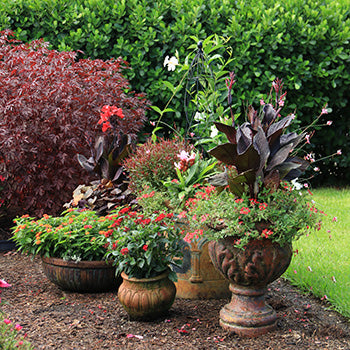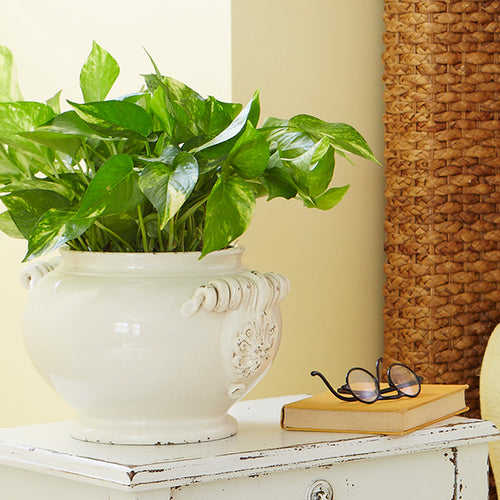By Doug Jimerson
Although it may be cool (or downright cold) outdoors, there are still thinks you can do in your garden. See these tips.

1. Plant Cold-Hardy Annuals in February
In Florida and other frost-free regions, you can plant cold-hardy annuals outdoors. Choose species that can take a light frost such as pansy, dianthus, sweet alyssum, dusty miller, sweet pea, osteospermum, and calendula. If unseasonable cold weather threatens, cover your plants with a light sheet (don’t use plastic, though) until the temperatures rebound. Make sure your cover is weighed down to keep it stable in windy conditions. And, use stakes to keep it from touching foliage. Move potted flowers into a protected location.
Tip: If cold weather threatens, water the soil around your plants thoroughly. Wet soil holds the heat better than dry soil and will help warm the air close to the soil surface.
2. Inspect Houseplants
Keep indoor plant pests, such as mealybug, scale, and spider mites at bay by giving your houseplants a physical exam every time you water. These creatures thrive in the dry winter atmosphere of your home and can disfigure your favorite plants. Control pests with an insecticidal soap or houseplant insecticide.Tip: Give your plants a weekly spritz in the shower to help wash off invading insect pests and to increase the humidity around the plant. Most indoor plants are tropical in nature so the more humidity you can provide, the happier your plant will be.
3. Plant a Terrarium
If it’s too cold to garden outdoors in February, why not design a garden under glass? To create a miniature jungle, look for clear-glass containers that have a lid or stopper that will help maintain a humid atmosphere around your plants. For plants such as succulents that prefer a drier climate, select a large, open-mouthed container. Then, look for plants that remain compact. Good choices for a moist environment include:- Pilea
- Pepperomia
- Ivy
- Lemon Button fern
- Baby tears
- Creeping fig
Tip: Before you add soil, spread a layer of aquarium gravel over the bottom of your terrarium. This will facilitate drainage if you over water. Then, place a layer of window screen over the gravel to help prevent the soil from washing down.
4. Feed the Birds in February
By late winter many natural food sources for local birds will begin to thin out. It’s important to keep your bird feeders fully stocked until spring. Offer a variety of foods to attract the widest selection of bird species. Black oil sunflowers, for example, draw cardinals, blue jays, juncos, and a host of other species. Beef suet is ideal for woodpeckers, mockingbirds, and nuthatches. And Nyjer seed is a finch favorite. Also, include a diverse selection of feeders such as tube, hopper, and platform to accommodate the feeding habits of different bird species.Tip: During winter you can often attract more songbirds to fresh water than you can to food. Use a heater to keep the water in your birdbath from freezing and add fresh water every few days.
5. Start Seeds
Start flowers and vegetables that benefit from an early start indoors in February. Use grow lights to germinate begonia, geranium, coleus, eggplant, and peppers. For best results, use a soilless seed-starting mix and hang grow lights just a few inches over the top of your plants. Use a timer to keep the grow lights on for 12 to 14 hours a day. Improve germination by using a heat mat underneath your plants to keep the soil warm. After your seedlings are up and growing, feed them with a diluted (at a quarter of the strength recommended on the packaging) solution of liquid fertilizer every time you water.Tip: Try not to start your plants too early. Read the seed pack to find out how many weeks it will take for your plants to develop into the ideal size for the garden. Then, count backwards from your last expected frost date to get an accurate start date.
6. Plant Cool-Weather Crops
If you live in the South or Far West, you can plant cool weather vegetables such as spinach, peas, greens, onions, potatoes, lettuce, Swiss chard, beets, carrots, and radishes in your February garden. To be sure your soil is ready for planting, squeeze a handful and if it forms a tight, muddy ball hold off on planting. Ideally, when squeezed, your soil should gently flake away when rubbed between your fingers.Tip: To increase harvests plant in wide rows instead of single file. Use your hoe to create a shallow 6 to 10 inch wide planting bed, toss in your seeds, and cover. It’s easy and you’ll get much more produce than you would lining up your vegetables like toy soldiers.
7. Prune Roses
Late winter, while the plants are still dormant, is the ideal time to prune roses. Remove dead branches and any bloom stalks left over from last year. A good rule of thumb is to prune roses, except climbers, back by about a third each year. This promotes compact growth and improves the overall form of the plant. Climbers can be left alone unless you want to trim stray branches.Tip: Good air circulation is important to maintain rose health. If your roses are growing into each other, prune them so air can flow between the plants. This helps prevent common fungal problems such as black spot disease.
8. Add Color Indoors
Brighten the dark, dreary days of winter with blooming tropical plants such as orchids and bromeliads. These plants provide a welcome dose of color to every room in your home. With minimum attention, orchids and bromeliads stay in bloom for months.Tip: For best effect, place three or more bromeliads or orchids together in an ornamental pot or urn. You’ll get bigger color show and the plants will also be easier to take care of because they aren’t scattered around your house. One watering will take care of all of them.
See some of the best flowering houseplants.
9. Plant Bulbs
In Florida and other frost-free regions, summer bulbs such as crinum, agapanthus, dahlia, gloriosa, gladiolus, and canna can be planted now. Site them where they will receive at least 6 to 8 hours of direct sunlight a day. Their only other requirement is well-drained soil that doesn’t remain wet and soggy after heavy rains. Mulch the bulbs to protect them from an unexpected cold snap and to minimize weeds.Tip: Enjoy bulb flowers weeks earlier by purchasing pre-sprouted plants at your local garden center. Bulbs are a snap to grow, but some take a while to break dormancy, so potted plants will jumpstart the color show.
10. Start a Journal
Maintaining a garden journal is one of the best ways of keeping tabs of how your garden performed each season. Take note of which vegetables tasted the best, what roses had the most fragrant blooms, the insect pests that gave you headaches, or container combinations that knocked your socks off. Write down everything you can think of, positive or negative, about your garden so you can refer to it as you prepare for another planting season. Also, make a point to take photographs of your garden every week so you can monitor its progress through the year.Tip: Scan the plant tags and empty seed packets to make digital records of everything in your garden. This way you’ll create a record of what’s growing in your garden and you won’t have to physically save a mixed pile of tags and packets.
February Gardening Questions?
We love to talk to other gardeners. Email us your questions and we'll have one of our experts get back to you!

















